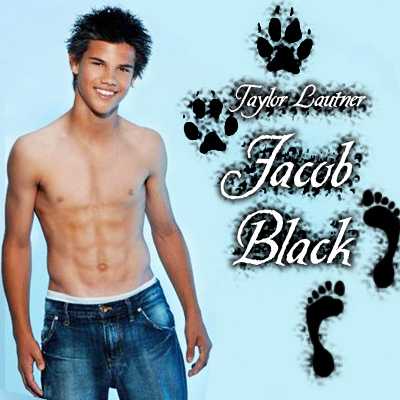Two critics agree with several points I've made before about
Twilight--especially in
Hotblooded Jacob in Eclipse:
Review: Twilight Saga: EclipseThree, and I realize I also put this under good, but the young men Quileutes are never wearing shirts! I realize I also put this under good, but the young men Quileutes are never wearing shirts! What's the problem? Well this continues a tradition in American pop culture that eroticizes Native men, see romance novels. Ok, so isn't it a good thing to be consider sexy? Well, not when that's your only representation. I need to explain further. In the story, featuring a love triangle between Edward, Bella, and Jacob, we get a fairly classic Romance-novel theme. Bella must choose between the refined, controlled, romantic Edward (who is white, btw), and the impulsive, lusty, shirtless Jacob (brown). In romance fiction, the person of color is almost always portrayed as the impulsive, lusty one. Native Americans get the whole wild, savage beat too. So, while it's great to be considered sexy, it's not so great to be though of as impulsive, not in control of your lust (Jacob forces a kiss on Bella until she punches him in the face), and hot-headed.
Fourth, the Native Americans turn into wolves for chrissakes. Can we say STEREOTYPE? Look, ok, we are magical forest creatures intimately connected with nature and all, and of course we are animal-like! We're noble savages! We imprint on people like ducks....What the? Ok, if this was a group of white people who turned into wolves then they'd be cool shapeshifters, but the stereotypes of Native Americans as mythical nature fairies adds another dimension. We've already been placed in the realm of fiction enough that some Americans forget we really exist...in like a contemporary way, just look at Peter Pan. Not only that, but these Natives constantly possess many of the animal attributes of the wolf, like the aforementioned impulsivity and imprinting. In short, this story paints Native Americans as closer to being animals than human. It's a slippery slope back to when people of color were considered by scientists to be sub-human, and were treated thus by society. I know that sounds extreme, but these can be the unconscious connections people make.
Fifth, oh for the love of god for some people this is their only exposure to Native Americans and they think we turn into wolves! OH THE HUMANITY!Vampires vs. werewolves: Race and rivalryBy Natalie ZutterFor the sake of argument, I'll be looking at the two most popular series/shows about vampires, werewolves, and all manner of creepy creatures: Twilight and True Blood. These two shows, though not the majority, have dictated many people's current views of the vampire and werewolf archetypes.
Vampires are ageless yet ancient, typically white and upper-class due to their centuries of existence: They are able to amass the resources and money as they move through the decades so that they are untouched by hunger or poverty. Werewolves, on the other hand, are often portrayed as people of color, living within a tribe (Native American or otherwise). Their "powers" are passed down through blood and heritage, carefully honed. Their coming of age is coming to terms with their shapeshifting capabilities.And:
It's little wonder that True Blood and Twilight both have their heroines briefly entranced by the pack mentality of the wolf lifestyle, by the non-white "other" and his earthy lifestyle, only to decide that the white man--who has all the material wealth to ensure that she's comfortable in her immortal life--is the one to commit to for all of eternity.Comment: For more on the subject, see
Magical Negroes and Indians,
White Vampire Yes, Indian Werewolf No, and
Stereotypes in the Twilight Series.
Below: "Yes, both my shirts and pants shred when I turn into a wolf. But wearing pants only makes me look like a sexy savage!"



2 comments:
I was unfortunate enough to see "Twilight: Eclipse" quite recently, and though the film has many, many problems, I don't agree that this racialised interpretation of Jacob's character is one of them.
The first review talks about how native Jacob is presented as this lusty, animalistic, dangerous love for Bella, while white Edward is the more refined, acceptable match. But if anything, the story constantly reiterates, with all the subtlety of a sledgehammer, that Jacob is the nice, safe, dependable match for Bella, who her dad approves of, while it's Edward who's the unpredictable, dangerous influence leading her down a dark path.
And I think suggesting that Jacob going topless is some meticulously inserted subliminal message to make viewers think of Native Americans as animalistic and thus inferior to whites is giving Stephanie Meyer far too much credit. It's more about "if I make the hot guy take his top off all the time the fangirls will scream and squee."
I covered some of the race and class issues in Race in Twilight Movie, John.
I've seen only the first movie, but Edward didn't strike me as especially unpredictable or dangerous. He's supposed to be dangerous, true, but he doesn't seem dangerous. And he's unpredictable only in a teenage "will he or won't he show up?" kind of way. True unpredictability would be drinking the blood of Bella's friends and family, or something like that.
If taking off the shirts was about making the fangirls scream, why have only the werewolves do it? Why not the vampires too? Nope, I'm sticking with my theses for now.
Post a Comment